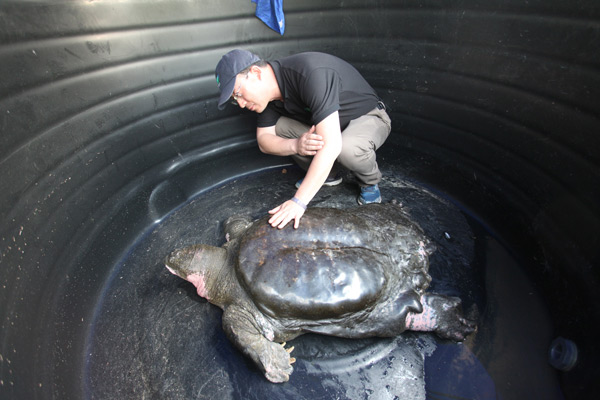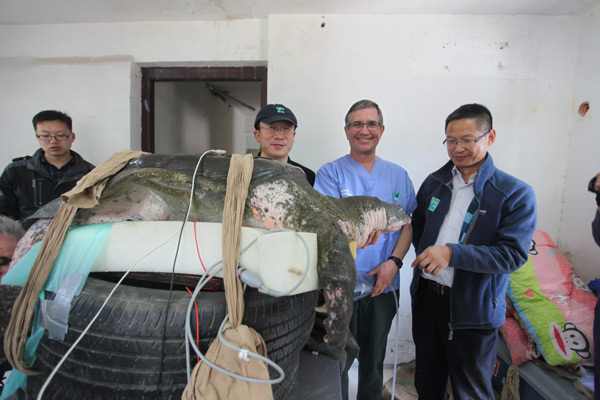


(A scientist looks at a Yangtze giant softshell turtle at Suzhou Zoo. Photo/Thepaper.cn)
The whole world’s hope for the survival of the rarest turtle species now rests on two turtles at Suzhou Zoo in Jiangsu province, as the female is expected to lay eggs in June after another round of artificial insemination.
This special turtle species, the Yangtze giant softshell turtle, is one of the most critically endangered animals in the world. It originally comes from China, and historically made its home in the Yangtze River and Taihu Lake. Only three Yangtze giant softshell turtles are known to be living.
The pair in Suzhou was given a third round of artificial insemination in April, and the result will come out in June, when the female lays eggs. Previous trials in 2015 and 2016 both failed to fertilize any eggs.
The female turtle is reportedly more than 90 years old, while the male over 110. The female turtle remains active in egg-laying, and can lay two to three nests of eggs, or 100 eggs in total. However, the male turtle cannot inseminate the eggs naturally due to a serious wound on its penis, Thepaper.cn reported.

(Chinese and oerseas scientists take photos with a Yangtze giant softshell turtle. Photo/Thepaper.cn)
Lü Shunqing, dean of the College of Life and Environment Sciences at Nanjing Forestry University, told Thepaper.cn that this may not be the end of the turtle pair in Suzhou, as the oldest recorded Yangtze giant softshell turtle died at more than 160 years old.
The genital wound on the male turtle was allegedly the result of an organized coupling some 20 years ago; the other turtle in that pairing, killed as a result of the unfortunate match-up, was later found to be another male, according to Huashi, a zoology editor at popular science website Guokr.
The editor told the People’s Daily Online that additional living turtles could potentially be found in some isolated but relatively complete habitats in the Honghe River region spreading from southwestern China's Yunnan province to northern Vietnam.
“Besides hoping for a miracle, though, I think for now we can only work to keep their gene and genital cell samples, and wait for future technology,” he said.
Meanwhile, Lü, who has been working to save the Yangtze giant softshell turtle for 10 years, noted that it remains an impossibility to clone turtles, as the cloning technology is not mature enough for reptiles.
The Guokr editor added that there is one more Yangtze giant softshell turtle living in Vietnam, and a fourth one died last January. The living one is believed to be male, but distance and the rarity of the animal makes it almost impossible for the male turtle in Vietnam to mate with the female turtle in eastern China.
Although the genetic diversity of the species is already largely wiped out, people must help the species to survive in any capacity, the editor noted, warning that many endangered species in China will soon face similar problems. Another species critically at risk is the Yangtze finless porpoise.

(A scientists checks on a Yangtze giant softshell turtle at Suzhou Zoo. Photo/Thepaper.cn)
 Fire brigade in Shanghai holds group wedding
Fire brigade in Shanghai holds group wedding Tourists enjoy ice sculptures in Datan Town, north China
Tourists enjoy ice sculptures in Datan Town, north China Sunset scenery of Dayan Pagoda in Xi'an
Sunset scenery of Dayan Pagoda in Xi'an Tourists have fun at scenic spot in Nanlong Town, NW China
Tourists have fun at scenic spot in Nanlong Town, NW China Harbin attracts tourists by making best use of ice in winter
Harbin attracts tourists by making best use of ice in winter In pics: FIS Alpine Ski Women's World Cup Slalom
In pics: FIS Alpine Ski Women's World Cup Slalom Black-necked cranes rest at reservoir in Lhunzhub County, Lhasa
Black-necked cranes rest at reservoir in Lhunzhub County, Lhasa China's FAST telescope will be available to foreign scientists in April
China's FAST telescope will be available to foreign scientists in April "She power" plays indispensable role in poverty alleviation
"She power" plays indispensable role in poverty alleviation Top 10 world news events of People's Daily in 2020
Top 10 world news events of People's Daily in 2020 Top 10 China news events of People's Daily in 2020
Top 10 China news events of People's Daily in 2020 Top 10 media buzzwords of 2020
Top 10 media buzzwords of 2020 Year-ender:10 major tourism stories of 2020
Year-ender:10 major tourism stories of 2020 No interference in Venezuelan issues
No interference in Venezuelan issues
 Biz prepares for trade spat
Biz prepares for trade spat
 Broadcasting Continent
Broadcasting Continent Australia wins Chinese CEOs as US loses
Australia wins Chinese CEOs as US loses